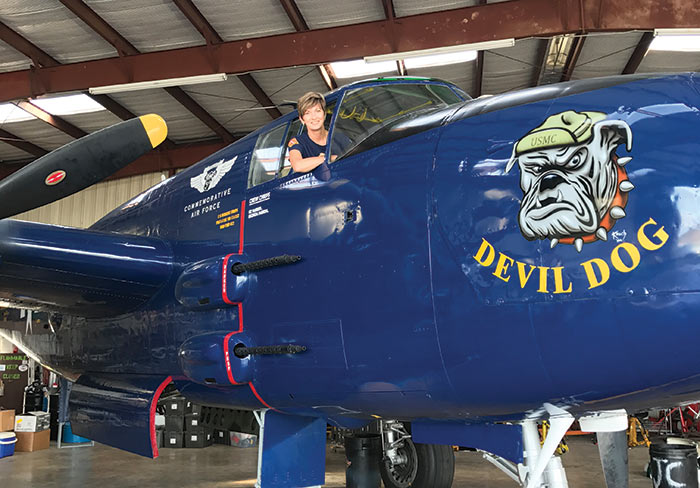Our Stories: Exploring Aviation’s History
United Pilot “Enlists” for CAF Duties
By John Perkinson, Senior Staff Writer

Capt. Valerie Scott (United) in the cockpit of the Commemorative Air Force’s Devil Dog, a PBJ-1J she flew to Oshkosh, Wis., this summer.
Capt. Valerie Scott (United) recently began training in a PBJ-1J, the U.S. Marine version of the vintage B-25 Mitchell bomber. The Commemorative Air Force’s (CAF) Devil Dog, as the aircraft is known, is much different from the airliner she usually flies, but she took on the challenge to expand her horizons. Scott, who’ll be retiring from United in a few years, is exploring new opportunities for the next chapter of her life.
“I’m in my final four, as I call it, and looking for something I can transition to,” she remarked.
When United Airlines opted to close its B-767/757 domicile in Denver, Colo., several years ago, Scott decided to stick with these aircraft types and transfer to the carrier’s Houston, Tex., pilot base. She and her husband, a retired corporate pilot, soon began nosing around FBOs near Georgetown, Tex., where they moved, hoping to get back into general aviation. The last FBO they visited is home to Devil Dog.
“I saw the plane in the back corner of the hangar and thought, ‘Okay, I’ve found my home,’” she said.
Devil Dog’s livery commemorates the Number 3 aircraft of Marine Bombing Squadron 612, which flew World War II Pacific-theater night attacks on enemy shipping, using radar to locate its targets. The original PBJ completed 22 missions before its demise.
Scott spent her first year with the Devil Dog Squadron as a docent, talking about the airplane’s history at air shows and selling souvenirs to help fund the operation. She eventually became an aircraft sponsor and now sits in the cockpit’s right seat. Most recently, she flew the aircraft to Oshkosh, Wis., to participate in this summer’s EAA AirVenture fly-in and convention.
In addition to her “bomber” responsibilities, Scott also joined the CAF’s memorial WASP Squadron. The original WASPs, or Women Airforce Service Pilots, made a name for themselves ferrying military aircraft more than 60 million miles during the 1940s, enabling male pilots to concentrate on combat missions. These 1,000-plus female aviators were required to have preexisting pilot licenses and were trained by the U.S. Army Air Forces at Avenger Field in Sweetwater, Tex.
Despite the program’s tremendous success, women serving as military pilots during this era was controversial, and, after the war, the WASPs were released from service. All WASP records became classified and were locked away for 35 years. It wasn’t until 1977 that the WASPs were rightfully granted veteran status, thanks to a law signed by President Jimmy Carter. In 2009, this revolutionary program was honored with the Congressional Gold Medal.
Scott noted that among its activities, the CAF WASPs are raising funds to purchase a T-6, one of the aircraft originally used to train the unit’s female pilots. Part of the CAF’s goal is to educate the public about aviation, and being able to see, touch, and ride in this classic airplane “would help young people relate to this period in history in a whole new way,” she acknowledged.
The United captain noted that the CAF is launching a new national educational outreach campaign, similar to its Red Tail project in 2011, honoring the Tuskegee Airmen. CAF Rise Above: WASP will recall the inspirational story of these extraordinary female aviators who overcame a social stigma to serve their country with honor and distinction. In addition to exhibits and presentations, the CAF is working on a documentary combining historic footage with interviews of surviving WASPs.
This past Memorial Day weekend, Scott attended a reunion at the National WASP WWII Museum in Sweetwater. “It was wonderful to meet these women who helped break the gender barrier for flying careers,” she noted, adding that 11 of them attended the ceremony. And as Scott approaches her imminent airline retirement and continues her burgeoning relationship with the CAF Devil Dog and WASP squadrons, it appears that aviation’s past could just be the key to her future.
What’s in a Name?
A “Devil Dog” is a nickname for a U.S. marine. To find out where this iconic aircraft performs next, go to www.devildogsquadron.com. To learn more about the CAF Rise Above: WASPS project, visit riseabovewasp.org.

